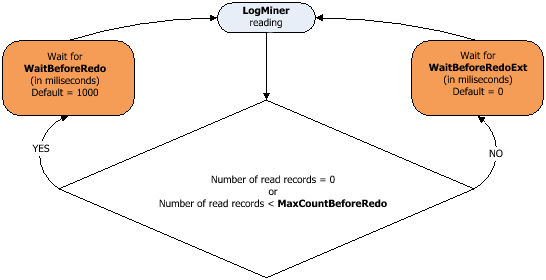DD_for_Oracle registry subkey
For each Oracle instance for which Talend Change Data Capture for Oracle Source has been installed, you get a key below the DD_for_Oracle key. Its name is the Oracle (SQLNet service) instance name.
For example, if you install or add an Oracle instance named ORACLE_DEV2, you will get a subkey named ORACLE_DEV2. This subkey can contain the following parameters specific to the instance indicated in the subkey name.
In this subkey, the following parameters will be applicable for this Oracle instance:
| Parameter | Description |
|---|---|
|
ActiveSessionInfo |
This parameter provides information on the username and session. In most cases it is not recommended to modify its value. However, it can be useful in case of bidirectional replication. For more information on how to use this parameter, contact Talend Support team. |
|
ConnectionMode |
This parameter activates the type of connection, in trigger mode only:
For more information, contact Talend Support team. |
|
ddMgrOciMode |
Connection mode of the Manager:
It is recommended to keep its value to 0. |
|
ddSchedulerOciMode |
Connection mode of the Oracle scheduler:
It is recommended to keep its value to 0. |
|
ddSpvOciMode |
Connection mode of the Oracle supervisor:
It is recommended to keep its value to 0. |
|
Journal |
This parameter configures the name of the journal table in the source database. |
|
MaxCountBeforeRedo |
This parameter configures the duration of the break between each reading of the LogMiner. The default value is set to 100. If the value is < 0, the value will be set to 100.
|
|
OciMode4Engine |
Connection mode of the engine:
It is recommended to keep its value to 0. |
|
OraclePort |
This parameter configures the port of connection used by Oracle. |
|
ParamPwd |
This parameter indicates the database password associated with the username (ParamUid parameter described below) that will be used by the Manager, the scheduler, the supervisor and the source engine to establish the connection to the database. The default value is the one provided after the installation (see Installing Oracle source). |
|
ParamUid |
This parameter indicates the Oracle username that will be used by the Manager, the scheduler, the supervisor and the source engine to establish the connection with Oracle. The default value is the one provided after the installation (see Installing Oracle source). |
|
SingleByte |
This parameter allows to convert the data read to single byte.
Used from version 6.13.1.0. |
|
TextMaxLength |
Its value contains the maximal length for a text area. The default value is set to 1000 characters. |
|
UniversalOciMode |
It is recommended to keep its value to 0. |
|
WaitBeforeReadLog |
Delay before next reading of transactions. It is only available in trigger mode. This parameter can reduce the CPU usage when there is no data. Default value is 100 ms. |
|
WaitBeforeRedo |
This parameter configures the duration of the break between each reading of the LogMiner. The default value is set to 1000 milliseconds, the minimum value is 10ms.
|
|
WaitBeforeRedoExt |
This parameter configures the duration of the break between each reading of the LogMiner. The default value is 0: there is no temporization, otherwise the waiting time is of x ms.
|
Did this page help you?
If you find any issues with this page or its content – a typo, a missing step, or a technical error – let us know how we can improve!

